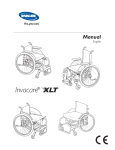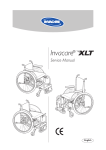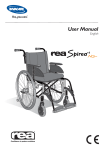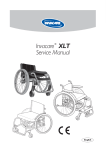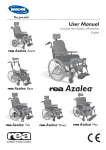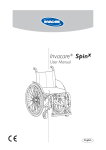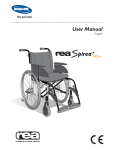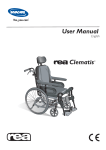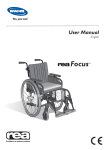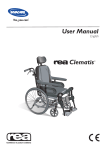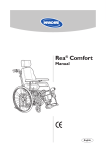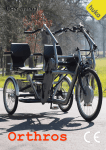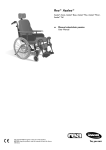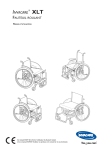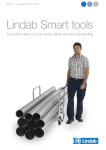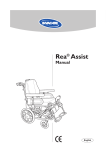Download XLT Swing User Manual 0813
Transcript
INVACARE® XLT WHEELCHAIR USER MANUAL EN ©Invacare Rea AB Every effort has been made to ensure that the contents of this publication are updated at the time of printing. As part of the ongoing improvement of the products, Invacare Rea AB reserves the right modify existing models at any time. Any use of this publication, or parts thereof, as well as any reproduction of images, must have the written consent of Invacare Rea AB 2 Invacare® XLT CONTENTS 1. General 1.1 Introduction 1.2 Symbols and signal words 1.3 Limitation of liability 1.4 Copyright protection 1.5 Warranty 1.6 Customer service 1.7 Accidents/near accident 1.8 Testing 1.9 Intended use 1.10 XLT models 4 4 4 4 4 4 4 4 4 5 5 2. Safety 2.1 Lifting the wheelchair 2.2 Daily performance check 2.3 Specific risks 6 6 6 6 3. Technical data 3.1 Dimensions and weight 3.2 Upholstery and frame colours 3.3 Equipment and accessories 3.4 Seat height tables 3.4.1 XLT active 3.4. 2 XLT dynamic 3.4. 3 XLT swing 3.4. 4 XLT max 3.5 Identification label 7 7 8 8 9 9 12 14 17 17 4. Set-up and installation 4.1 Delivery check 4.2 Wheelchair overview 4.3 Assembly 4.3.1 Rear wheels 4.3.2 Backrest 4.3.3 Armrests 4.3.4 Legrests 18 18 18 18 18 18 19 19 5. Components and their function 20 5.1 Footbow 20 5.1.1 High mounted footbow 20 5.1.2 Footbow XLT max 20 5.2 Fixed legrests 21 5.3 Angle adjustable legrests 21 5.4 Calf pads 22 5.5 Depth- and angle adjustable footplates 22 5.6 Footrests one-piece 22 5.6.1 Footrest, one piece (xlt swing) 23 5.6.2 Footboard converter xlt max 23 5.7 Seat 24 5.7.1 Adjusting the seat depth 24 5.7.2 Adjusting the shape 24 5.8 Backrest 24 5.8.1 Angle adjustment 24 5.8.2 Angle adjustment, fine adjustments 25 5.8.3 Height adjustments 26 Invacare® XLT 5.9 Armrests/mudguard 5.9.1 Flip-up armrests 5.9.2 Detachable armrest 5.9.3 Mudguards 5.9.4 Adjusting the play 5.10 Brakes 5. 10.1 Adjusting the brake 5. 10. 2 Using the standard brake 5. 10. 3 Using the performance brake 5.11 Rear wheel attachment 5.12 Rear wheel attachment xlt max 5.13 Castor wheels 5.13.1 Adjusting the castor angle 5.14 Accessories 5.14.1 Anti-tippers 5.14.2 Trunk support 5.14.3 One-arm drive 5.14.4 Anti-tip device for one-arm drive 5.14. 5 Assistant manoeuvred drumbrakes 5.14. 6 Amputee legrest 5.14.7 External push handles 5.14.8 Foldable push handles 5.14. 9 Head and neckrest 5.14. 10 Pelvic belt 26 26 26 27 27 27 27 27 28 28 29 30 30 30 30 32 33 33 6. Using the wheelchair 6.1 Moving to/and from the wheelchair 6.3 Propelling up a slope 6.2 Stretching and bending 6.4 Propelling down a slope 6.5 Onto a kerb/ off a kerb 6.6 Kerbs - alternative method 37 37 37 37 37 38 38 7. Transport 7. 1 Transporting wheelchairs vehicles 7. 2 Restraint methods 7. 2 Transport it as luggage 39 39 40 41 8. Maintenance 8.1 Safety information 8.2 Maintenance schedule 8.3 Cleaning 42 42 42 43 9. After use 44 34 35 35 35 36 36 3 1. GENERAL 1.1 INTRODUCTION Invacare® XLT is a wheelchair with many adjustment options and accessories. To ensure that you benefit as much as possible from your Invacare® XLT, and in order to do its options justice, the chair must be tested and adjusted by competent personnel. We hope that you have also received instructions for using your Invacare® XLT in everyday life. The Invacare® XLT frame, footbow and backrest are manufactured from high quality titanium. For the Swing version the legrest hangers are made from aluminium. The cover for the seat cushion is made of Jemima and the backrest cover is made of nylon. This manual includes a description of the parts of the chair, simple adjustment options, how to use the Invacare® XLT safely and how to transport it. The manual must be read thoroughly before the chair is used. Also included in this manual is a description of how the most common accessories are fitted and also some slightly more advanced settings. As the Invacare® XLT has many different components and accessories, the appearance of the accessories you have for your chair may differ from those shown. 1.2 SYMBOLS AND SIGNAL WORDS Symbols and signal words are used in this manual and apply to hazards or unsafe practices which could result in personal injury or property damage. See the information below for definitions of the signal words. Warning Warning indicates a potentially hazardous situation which, if not avoided, could result in death or serious injury Caution Caution indicates a potentially hazardous situation which, if not avoided, may result in property damage or minor injury or both Important Indicates a hazardous situation that could result in damage to property if it is not avoided 4 1.3 LIMITATION OF LIABILITY Invacare Rea AB accepts no liability for damage arising from: Non-compliance with the User Manual Incorrect use Natural wear and tear Incorrect assembly or set-up by the purchaser or a third party Technical modifications Unauthorised modifications and/or use of unsuitable spare parts The written authorisation of Invacare Rea AB must be obtained before installing additional adaptations on an Invacare Rea wheelchair. Otherwise no liability claims can be made. 1.4 COPYRIGHT PROTECTION All information quoted is believed to be correct at time of print.Invacare® reserves the right to alter product specifications without prior consultation. Rea, Rea design and DSS (Dual Stability System) design are registered trademarks of Invacare® International. 1.5 WARRANTY We provide a two-year guarantee from the delivery date. Damage due to wear and tear on upholstery, tyres, (rubber) tubes, hand rims and castors etc., is not covered by the guarantee. Damage that has been caused through physical violence or abnormal use is not covered. Damage caused by users who weigh more than 135 kg is not covered. The guarantee will only apply if the maintenance instructions are followed. 1.6 CUSTOMER SERVICE For contact details please refer to the last page of this publication where you will find addresses to the European sales companies. 1.7 ACCIDENTS/NEAR ACCIDENT Please inform your Invacare office immediately of any accidents or near-accidents that have been caused by this wheelchair and that have led to, or could have led to, personal injury. The relevant authority must also be contacted and reported to. 1.8 TESTING The Invacare® XLT has been tested and approved TÜV and is CE-marked according to the Medical Device Directive. Invacare® XLT 1.9 INTENDED USE 1.10 XLT MODELS for those who use the wheelchair for a longer period of time, i.e. several hours in a row. can manoeuvre the wheelchair him/herself, as well as for the user who requires assistance. that makes it possible to adjust the sitting posture so it stays comfortable for several hours. 1. XLT Active (75° knee angle) The XLT Active front is designed to hold your feet and lower parts of your leg steady. The footbow is standard. ties. With the right adjustments, carried out by a professional, the wheelchair can be set up specifically for a user and according to the requirements of a possible assistant. outdoors on level ground and paved areas. We recommend the larger wheels when the wheelchair is used on uneven ground. ! Invacare® XLT could tip backwards, when being wheeled uphill, especially when the incline is more than 8°. Or if the rear wheels are mounted in their formost position on the rear wheel attachment. The effect of mounting the rear wheels in their foremost position is that the chair will be easier to manoeuvre. However, there is the increased risk of tipping backwards. Therefore the use of anti tip devices to achieve better stability is strongly recommended. ion on the seat. The seat cushion improves the user’s body posture and makes it possible to sit comfortably for longer periods of time. Invacare® XLT with a backrest, adjusted to a height of minimum 40 cm, a neckrest and a pelvic belt can be used as a seat in a vehicle. For other configurations the user must transfer to the normal seat in a car or bus. 2. XLT Dynamic (90° knee angle) The XLT Dynamic is designed to hold your feet steady. The total length of the wheelchair is very compact. The footbow is standard. 3. XLT Swing (80°, 90° and angle adjustable legrests) The XLT Swing is designed with a front offering more space for the feet and lower parts of the legs. The standard delivery includes collapsible footrests. 4. XLT Max (75°) The XLT Max is designed for larger users and has a user weight capacity of 180 kg. Invacare® XLT 5 2. SAFETY 2.1 LIFTING THE WHEELCHAIR 2.2 DAILY PERFORMANCE CHECK Check that the following parts are securely fitted on the wheelchair and operational: " #! #! $% & ' & * ' & !%+ & 2.3 SPECIFIC RISKS Below you will find a number of points affecting your personal safety. Read them carefully! Failure to comply with instructions given may result in personal injury and/or product damage. Check each of the following before using the wheelchair: -that all parts are attached securely to the frame -that all wheels and knobs are properly tightened -that all brakes and anti-tip devices function correctly Always lift the wheelchair by grabbing the frame at the points shown in the picture. Never lift the wheelchair by the removable armrests or the footrests. Ensure that the backrest and push handles are securely in place. Also read the chapter Safety instructions/Propelling techniques. 6 rests, footrests, backrest bar or by the adjustable push handles. $ ! of the chair. out of the chair, because of the risk of tipping. < ! of tipping over. & and this may cause injury to your hands. = > % ? % operated brake is reduced in wet and slippery conditions, as well as when on a slope. # securely attached. @ user is sitting in the chair. ! G Q are slackened the greater the risk of tipping the wheelchair becomes. Y ! upholstery can with long time exposure to sun reach temperatures over 41 °C. Invacare® XLT 3. TECHNICAL DATA 3.1 DIMENSIONS AND WEIGHT Seat width Legrest length Seat depth Tilt adjustment Total length Weight Seat height Backrest height Armrest height Backrest adjustment Total width Total height Maximum user weight Transport weight * Fixed/Angle adjustable backrest **Our wheelchairs are crash tested according to the ISO norm 7176-19 (Wheeled mobility devices for use as seats in motor vehicles) See the chapter on Transport for more details. Wheelchair users should however transfer to the vehicle seat and use the vehicle installed restraint system whenever it is feasible. SW (MM) SD (MM) SH (MM)* BH (MM)* AH (MM) LL (MM)* SA (°) BA (°) W (MM)** H (MM) L (MM) M (KG) ML (KG) TW (KG)*** ACTIVE 355/380/405/ 430/455/480 DYNAMIC 355/380/405/ 430/455/480 SWING 330/355/380/405/ 430/455/480/505 MAX 505/555/ 605 360-400/410-450/ 460-500 400-520 360-400/410-450/ 460-500 400-500 360-400/410-450/ 460-500 500/550/600 200-350 / 300-490 210-310 380-505 0°-14° ±10° 200-350 / 300-490 210-310 355-485 0°-14° ±10° 390-520 200-350 / 300-490 210-310 280-510 0°-14° ±10° 440-520 400-490 SEAT WIDTH +200 MM 610-1050 830-1030 9,8 135 6 SEAT WIDTH +200 MM 610-1050 730-880 9,8 135 6 SEAT WIDTH +200 MM 610-1050 820-1230 11,3 135 6 SEAT WIDTH +210 MM 790-1100 930-1080 15,5 KG 180KG 11,1 KG 380-480 0°-14° ±10° * without seat cushion ** with 0° camber *** without rearwheels and accessories Invacare® XLT 7 3.2 UPHOLSTERY AND FRAME COLOURS Backrest cover Black Nylon TR33 Seat cushion cover Black Jermina TR18 (standard) Frame colours Black, Grey, Blue, Red, Blasted titanium and Orange 3.3 EQUIPMENT AND ACCESSORIES Invacare® XLT has a wide range of accessories and options. Some of the accessories may not be available in all countries. Backrest Tension adjustable Angle adjustable, fixed or height adjustable Narrow back Seat Tension and depth adjustable seat Seat cushions Standard 5 cm Legrests Footbow rigid** Footbow rigid with footplate** Footrest one piece, flipup, angle adjustable Footrest, high mounted** 80° & 90° fixed legrest* Angle adjustable legrest* Fixed footplate* Angle and depth adjustable footplate* Others Several types of handrims Spoke guard Anti-tip device Trunk Support Reflectors Kit Table Tray Pump Cane holder Tool kit Various push handles Pelvic belt Mudguard Sideguard Step tube Brake lever extension Mounting brackets for E-Motion and E-Fix * for XLT Swing only ** for XLT Active and Dynamic only Armrests Flip-up armrest with long or short pad Height adjustable armrest with long or short pad Hemi armrest Castors 75 - 125 mm (Dynamic), 75 - 180 mm (Swing, Active) Rear wheels 22", 24", 25", 26" pneumatic or puncture-proof 24", one-arm drive Brake User-brake (3 types) Carer-operated drumbrake One-arm brake 8 Invacare® XLT 3.4 SEAT HEIGHT TABLES 3.4.1 xlt active XLT Active SHf 7 5 3 1 SHr 6 4 2 2 A BCD SHf SHr 1 2 3 4 L=75 5 6 4 3 1 L=110 L L=150 mm * 22" 40 40 39 38 2 75 (3") 41 41 40 39 38 1 75 (3") 41 41 40 39 38 2 100 (4") 1 42 41-42 40 39 38 43 43 41-42 40 39 38 2 100 (4") 75 (3") 43 43 41-42 40 39 38 4 125 (5") 43 43 41-42 40 39 38 3 100 (4") 43 43 41-42 40 39 38 140 (5,5") 1 125 (5") 44 44 43 41-42 40 39 38 4 44 44 43 41-42 40 39 38 1 75 (3") 44 44 43 41-42 40 39 38 3 125 (5") 44 44 43 41-42 40 39 38 2 100 (4") 45 44 43 41-42 40 39 38 3 140 (5,5") 45 44 43 41-42 40 39 38 1 100 (4") 45 44 43 41-42 40 39 38 2 125 (5") 45 44 43 41-42 40 39 38 3 150 (6") 46 44 43 41-42 40 39 38 2 140 (5,5") 47 44 43 41-42 40 39 38 1 125 (5") 47 44 43 41-42 40 39 38 2 47 44 43 41-42 40 39 38 2 75 (3") 47 44 43 41-42 40 39 38 3 100 (4") 47 44 43 41-42 40 39 38 4 47 44 43 41-42 40 39 48 44 43 41-42 40 39 48 44 43 41-42 40 39 1 48 44 43 41-42 40 39 2 48 44 43 41-42 40 1 75 (3") 48 44 43 41-42 40 2 100 (4") 48 44 43 41-42 40 3 125 (5") 48 44 43 41-42 40 4 150 (6") 49 44 43 41-42 40 3 140 (5,5") 49 44 43 41-42 40 49 44 43 41-42 1 100 (4") 50 44 43 41-42 2 125 (5") 50 44 43 41-42 3 150 (6") 50 44 43 4 180 (7") 50 44 43 2 140 (5,5") 51 44 43 1 125 (5") 51 44 43 2 150 (6") 51 44 43 3 180 (7") 51 44 43 1 140 (5,5") 52 44 44 1 150 (6") 52 44 44 2 180 (7") 150 (6") 1 125 (5") 140 (5,5") 4 140 (5,5") 150 (6") 180 (7") 1 180 (7") * = Not applicable SD =seat depth Invacare® XLT 9 SHf 7 5 3 1 SHr 6 4 2 2 A BCD SHf SHr 1 2 3 4 5 L=75 4 3 1 L=110 L L=150 mm * 6 24"/25" Low profile 40 40 2 75 (3") 41 41 40 1 75 (3") 41 41 40 2 100 (4") 42 41-42 40 1 100 (4") 43 43 41-42 40 2 75 (3") 43 43 41-42 40 4 125 (5") 43 43 41-42 40 3 100 (4") 43 43 41-42 40 44 43 41-42 40 4 140 (5,5") 44 1 125 (5") 43 41-42 40 1 75 (3") 44 44 43 41-42 40 3 125 (5") 44 44 43 41-42 40 2 100 (4") 45 45 44 43 41-42 40 3 140 (5,5") 45 45 44 43 41-42 40 1 100 (4") 45 45 44 43 41-42 40 2 125 (5") 45 45 44 43 41-42 40 3 150 (6") 46 46 45 44 43 41-42 40 2 140 (5,5") 47 46-47 45 44 43 41-42 40 1 125 (5") 47 46-47 45 44 43 41-42 40 2 47 46-47 45 44 43 41-42 40 2 75 (3") 47 46-47 45 44 43 41-42 40 3 100 (4") 47 46-47 45 44 43 41-42 40 4 47 46-47 45 44 43 41-42 40 48 46-47 45 44 43 41-42 40 48 46-47 45 44 43 41-42 40 48 46-47 45 44 43 41-42 40 48 46-47 45 44 43 41-42 40 1 75 (3") 48 46-47 45 44 43 41-42 40 2 100 (4") 48 46-47 45 44 43 41-42 40 3 125 (5") 48 46-47 45 44 43 41-42 40 4 150 (6") 49 46-47 45 44 43 41-42 40 3 140 (5,5") 49 46-47 45 44 43 41-42 40 49 46-47 45 44 43 41-42 40 1 100 (4") 50 46-47 45 44 43 41-42 40 2 125 (5") 50 46-47 45 44 43 41-42 3 150 (6") 50 46-47 45 44 43 41-42 4 180 (7") 50 46-47 45 44 43 41-42 2 140 (5,5") 51 46-47 45 44 43 41-42 1 125 (5") 51 46-47 45 44 43 41-42 2 150 (6") 51 46-47 45 44 43 41-42 3 180 (7") 51 46-47 45 44 43 1 140 (5,5") 52 46-47 45 44 43 1 150 (6") 52 46-47 45 44 43 2 180 (7") 150 (6") 1 4 * D1-4 (SD40) * D1-3 (SD40) 140 (5,5") 1 150 (6") 2 180 (7") 1 * D1-5 (SD40) 125 (5") 140 (5,5") 180 (7") * = Not applicable SD =seat depth 10 Invacare® XLT SHf 7 5 3 1 SHr 6 4 2 2 A BCD SHf SHr 1 2 3 4 5 L=75 4 3 1 L=110 L L=150 mm * 6 26" Low profile 41 41 41 1 75 (3") 100 (4") 41 2 42 42 41 1 43 42-43 41 2 75 (3") 43 42-43 41 4 125 (5") 43 42-43 41 3 100 (4") 43 42-43 41 100 (4") 1 125 (5") 44 44 42-43 41 4 44 44 42-43 41 1 75 (3") 44 44 42-43 41 3 125 (5") 44 140 (5,5") 44 42-43 41 2 100 (4") 45 45 44 42-43 41 3 140 (5,5") 45 45 44 42-43 41 1 100 (4") 45 45 44 42-43 41 2 125 (5") 45 45 44 42-43 41 3 150 (6") 46 * D4 (SD40) 46 45 44 42-43 41 2 140 (5,5") 47 47 46 45 44 42-43 41 1 125 (5") 47 47 46 45 44 42-43 41 2 150 (6") 47 47 46 45 44 42-43 41 2 75 (3") 47 47 46 45 44 42-43 41 3 100 (4") 47 47 46 45 44 42-43 41 4 125 (5") * D2 (SD40) 47 47 46 45 44 42-43 41 48 47-48 46 45 44 42-43 41 1 140 (5,5") 48 47-48 46 45 44 42-43 41 * D2 (SD40) 1 48 47-48 46 45 44 42-43 41 * D2-6 (SD40) 2 48 47-48 46 45 44 42-43 41 1 75 (3") 48 47-48 46 45 44 42-43 41 2 100 (4") 48 47-48 46 45 44 42-43 41 3 125 (5") 48 47-48 46 45 44 42-43 41 4 150 (6") 49 47-48 46 45 44 42-43 41 3 140 (5,5") 49 47-48 46 45 44 42-43 41 49 47-48 46 45 44 42-43 41 50 47-48 46 45 44 42-43 41 2 125 (5") 50 47-48 46 45 44 42-43 41 * D1 (SD40) 3 150 (6") 50 47-48 46 45 44 42-43 41 * D1-6 (SD40) 4 180 (7") 50 47-48 46 45 44 42-43 41 2 140 (5,5") 51 47-48 46 45 44 42-43 41 1 125 (5") 51 47-48 46 45 44 42-43 41 51 47-48 46 45 44 42-43 41 51 47-48 46 45 44 42-43 41 52 47-48 46 45 44 42-43 52 47-48 46 45 44 42-43 4 * C1,D1-6 (SD40) 150 (6") 180 (7") 1 180 (7") 1 *D1-6 (SD40) * D1-6 (SD40) 140 (5,5") 100 (4") 2 150 (6") 3 180 (7") 1 140 (5,5") 1 150 (6") 2 180 (7") * = Not applicable SD =seat depth Invacare® XLT 11 3.4. 2 XLT Dynamic SHf 7 5 3 1 SHr 6 4 2 2 A BCD SHf SHr 1 2 3 4 L=75 5 4 3 1 L=110 L L=150 mm * 6 22" 39 40 41 42 39 38 2 75 (3") 40 39 38 1 75 (3") 40 39 38 2 100 (4") 41-42 40 39 38 1 100 (4") 43 43 41-42 40 39 38 2 75 (3") 43 43 41-42 40 39 38 4 125 (5") 43 43 41-42 40 39 38 3 100 (4") 43 43 41-42 40 39 38 44 43 41-42 40 39 38 44 43 41-42 40 39 38 * D3 (SD40) 1 * D2 (SD40) 125 (5") 1 75 (3") 3 125 (5") 44 44 43 41-42 40 39 38 2 100 (4") 45 44 43 41-42 40 39 38 1 100 (4") 45 44 43 41-42 40 39 38 * D1 (SD40) 2 125 (5") 46 44 43 41-42 40 * D1 (SD40) 1 47 44 43 41-42 40 2 75 (3") 47 44 43 41-42 40 3 100 (4") 47 44 43 41-42 4 125 (5") 48 44 43 41-42 1 75 (3") 48 44 43 41-42 2 100 (4") 48 44 43 41-42 3 125 (5") 49 44 43 41-42 1 100 (4") 49 44 43 41-42 50 44 43 125 (5") 2 125 (5") 1 125 (5") 24" / 25" Low profile 40 40 41 42 12 1 75 (3") 40 2 100 (4") 41-42 40 1 100 (4") 43 43 41-42 40 * D5 (SD40) 2 75 (3") 43 43 41-42 40 * D1-6 (SD40) 4 125 (5") 43 43 41-42 40 * D5 (SD40) 3 100 (4") 43 43 41-42 40 * D1-6 (SD40) 1 125 (5") 44 44 43 41-42 40 * D4-5 (SD40) 1 75 (3") 44 44 43 41-42 40 * D1-6 (SD40) 3 125 (5") 44 44 43 41-42 40 * D4 (SD40) 2 100 (4") 45 45 44 43 41-42 40 * D3-4 (SD40) 1 100 (4") 45 45 44 43 41-42 40 * D3-6 (SD40) 2 125 (5") 1 46 46 45 44 43 41-42 40 * D2-6 (SD40) 47 46-47 45 44 43 41-42 40 * D2-4 (SD40) 2 75 (3") 47 46-47 45 44 43 41-42 40 * D2-4 (SD40) 3 100 (4") 47 46-47 45 44 43 41-42 40 * D2-5 (SD40) 4 125 (5") 48 46-47 45 44 43 41-42 40 * D1-4 (SD40) 1 75 (3") 48 46-47 45 44 43 41-42 40 * D1-4 (SD40) 2 100 (4") 48 46-47 45 44 43 41-42 40 * D1-5 (SD40) 3 125 (5") 49 46-47 45 44 43 41-42 * D1-4 (SD40) 1 100 (4") 49 46-47 45 44 43 41-42 * D1-4 (SD40) 2 125 (5") 50 46-47 45 44 43 * D1-6 (SD40) 1 125 (5") * = Not applicable SD =seat depth 125 (5") Invacare® XLT SHf 7 5 3 1 SHr 6 4 2 2 A BCD SHf SHr 1 2 3 4 5 L=75 4 3 1 L=110 L L=150 mm * 6 26" Low profile 42 41 * D1-6 (SD40) 43 42-43 41 * D1-6 (SD40) 2 75 (3") 43 42-43 41 * D1-6 (SD40) 4 125 (5") 43 42-43 41 * D1-6 (SD40) 43 42-43 41 * D1-6 (SD40) 44 44 100 (4") 3 100 (4") 1 125 (5") 42-43 41 * D1-6 (SD40) 1 75 (3") 42-43 41 * D1-6 (SD40) 3 125 (5") 44 42-43 41 * D1-6 (SD40) 2 100 (4") 44 44 1 45 45 44 42-43 41 * D1-6 (SD40) 1 100 (4") 45 45 44 42-43 41 * D1-6 (SD40) 2 125 (5") 46 45 44 42-43 41 * D1-6 (SD40) 1 125 (5") 46 47 47 46 45 44 42-43 41 * D1-6 (SD40) 2 75 (3") 47 47 46 45 44 42-43 41 * D1-6 (SD40) 3 100 (4") 47 47 46 45 44 42-43 41 * D1-6 (SD40) 4 125 (5") 48 47-48 46 45 44 42-43 41 * D1-6 (SD40) 1 75 (3") 48 47-48 46 45 44 42-43 41 * D1-6 (SD40) 2 100 (4") 48 47-48 46 45 44 42-43 41 * D1-6 (SD40) 3 125 (5") 49 47-48 46 45 44 42-43 41 * D1-6 (SD40) 1 100 (4") 49 47-48 46 45 44 42-43 41 * D1-6 (SD40) 2 125 (5") 50 47-48 46 45 44 42-43 * D1-6 (SD40) 1 125 (5") * = Not applicable SD =seat depth Invacare® XLT 13 3.4. 3 XLT Swing SHf 7 5 3 1 SHr 6 4 2 2 A BCD SHf SHr 1 2 3 4 5 6 L=75 4 3 1 L=110 L L=150 mm * 7 22" 39 40 41 41 42 39 38 2 75 (3") 40 39 38 1 75 (3") 40 39 38 2 100 (4") 1 41-42 40 39 38 43 43 41-42 40 39 38 2 100 (4") 75 (3") 43 43 41-42 40 39 38 4 125 (5") 43 43 41-42 40 39 38 3 100 (4") 43 43 41-42 40 39 38 44 43 41-42 40 39 38 4 140 (5,5") 44 43 41-42 40 39 38 1 75 (3") 44 43 41-42 40 39 38 3 125 (5") 44 43 41-42 40 39 38 2 100 (4") 3 140 (5,5") 1 * D1-2 (SD40) 125 (5") 45 44 43 41-42 40 39 38 45 44 43 41-42 40 39 38 1 100 (4") 45 44 43 41-42 40 39 38 2 125 (5") 45 44 43 41-42 40 39 38 3 150 (6") 46 44 43 41-42 40 39 2 140 (5,5") 47 44 43 41-42 40 39 1 125 (5") 47 44 43 41-42 40 39 47 44 43 41-42 40 39 2 75 (3") 47 44 43 41-42 40 39 3 100 (4") 47 44 43 41-42 40 39 4 47 44 43 41-42 40 * D1-2 (SD40) * D1-4 (SD40) * D1-2 (SD40) 2 150 (6") 1 125 (5") 140 (5,5") 48 44 43 41-42 40 * D1-2 (SD40) 48 44 43 41-42 40 * D1-3 (SD40) 1 4 48 44 43 41-42 40 * D1-6 (SD40) 2 48 44 43 41-42 40 1 75 (3") 48 44 43 41-42 40 2 100 (4") 48 44 43 41-42 40 48 44 43 41-42 40 49 44 43 41-42 * D1-2 (SD40) * C1-2,D1-6 (SD40) + D1-2 (SD45) 140 (5,5") 150 (6") 180 (7") 3 125 (5") 4 150 (6") 3 140 (5,5") 49 44 43 41-42 1 180 (7") 49 44 43 41-42 50 44 43 41-42 2 125 (5") 50 44 43 41-42 * D1-2 (SD40) 3 150 (6") 50 44 43 41-42 * D1-6 (SD40) 4 180 (7") 50 44 43 2 140 (5,5") 51 44 43 1 125 (5") 51 44 43 51 44 43 1 100 (4") 2 150 (6") * C1,D1-6 (SD40) + D1 (SD45) 3 180 (7") 51 44 1 140 (5,5") 52 44 * D1-6 (SD40) 1 150 (6") 52 44 * D1-6 (SD40) 2 180 (7") * = Not applicable SD =seat depth 14 Invacare® XLT 7 5 3 1 SHf 6 4 2 2 A BCD SHf SHr 1 2 3 4 5 L=75 4 3 1 L L=110 L=150 mm * 6 24"/25" Low profile 40 40 2 75 (3") 41 40 1 75 (3") 41 41 40 2 100 (4") 42 41-42 40 1 41 100 (4") 43 43 41-42 40 2 75 (3") 43 43 41-42 40 4 125 (5") 43 43 41-42 40 3 100 (4") 4 140 (5,5") 43 43 41-42 40 44 44 43 41-42 40 1 44 44 43 41-42 40 1 75 (3") 44 44 43 41-42 40 3 125 (5") 44 44 43 41-42 40 2 100 (4") * D4-6 (SD40) 45 45 44 43 41-42 40 3 140 (5,5") 45 45 44 43 41-42 40 1 100 (4") 45 45 44 43 41-42 40 2 125 (5") 45 * D3-6 (SD40) 125 (5") 45 44 43 41-42 40 * D1-6 (SD40) 3 150 (6") 46 46 45 44 43 41-42 40 * D2-5 (SD40) 2 140 (5,5") 47 46 45 44 43 41-42 40 * D1 (SD40) 1 125 (5") 47 46 45 44 43 41-42 40 * D2-6 (SD40) 2 47 46 45 44 43 41-42 40 2 75 (3") 47 46 45 44 43 41-42 40 3 100 (4") 47 46 45 44 43 41-42 40 4 125 (5") 47 46 45 44 43 41-42 40 * D1-5 (SD40) 48 46 45 44 43 41-42 40 * D1-4 (SD40) 48 46 45 44 43 41-42 40 1 48 46 45 44 43 41-42 40 2 48 46 45 44 43 41-42 40 1 75 (3") 48 46 45 44 43 41-42 40 2 100 (4") 48 46 45 44 43 41-42 40 3 125 (5") 48 46 45 44 43 41-42 40 4 150 (6") 49 46 45 44 43 41-42 3 140 (5,5") 49 46 45 44 43 41-42 49 46 45 44 43 41-42 1 100 (4") 50 46 45 44 43 41-42 2 125 (5") 50 46 45 44 43 41-42 * D1-6 (SD40) 3 150 (6") 50 46 45 44 43 * C1-7,D1-6 (SD40) + D1-6 (SD45) 4 180 (7") 50 46 45 44 43 * D1-3 (SD40) 2 140 (5,5") 51 46 45 44 43 1 125 (5") 51 46 45 44 43 * D1-6 (SD40) 2 150 (6") 43 * C1-6,D1-6 (SD40) + D1-6 (SD45) 3 180 (7") 150 (6") 1 140 (5,5") 4 * D1-6 (SD40) * D1-4 (SD40) 140 (5,5") 150 (6") 180 (7") 1 180 (7") 51 46 45 44 51 46 45 44 * D1-3 (SD40) 1 140 (5,5") 52 46 45 44 * D1-6 (SD40) 1 150 (6") 52 46 45 44 * C1-6,D1-6 (SD40) + D1-6 (SD45) 2 180 (7") * = Not applicable SD =seat depth Invacare® XLT 15 7 5 3 1 SHr SHf 6 4 2 2 A BCD SHf SHr 1 2 3 4 5 L=75 4 3 1 L=110 L L=150 mm * 6 26" Low profile 41 41 1 75 (3") 41 41 2 100 (4") 1 42 42 41 43 42-43 41 2 75 (3") 43 42-43 41 4 125 (5") 43 42-43 41 3 100 (4") 43 42-43 41 * D6 (SD40) * D1-6 (SD40) 44 44 42-43 41 42-43 41 44 42-43 41 44 44 44 * D5-6 (SD40) 100 (4") 1 125 (5") 4 140 (5,5") 1 75 (3") 3 125 (5") 44 42-43 41 2 100 (4") 45 45 44 42-43 41 * D1-6 (SD40) 3 140 (5,5") 45 45 44 42-43 41 * D4 (SD40) 1 100 (4") 45 45 44 42-43 41 * D4 (SD40) 2 125 (5") 45 46 45 44 42-43 41 * C4-5,D1-6 (SD40) + D4-5 (SD45) 3 150 (6") 46 45 44 42-43 41 * D1-6 (SD40) 2 140 (5,5") 125 (5") 47 47 46 45 44 42-43 41 * D2-4 (SD40) 1 47 47 46 45 44 42-43 41 * C2-3,D1-6 (SD40) + D2-3 (SD45) 2 47 47 46 45 44 42-43 41 47 47 46 45 44 42-43 41 47 47 46 45 44 42-43 41 47 47 46 45 44 42-43 41 * D1-6 (SD40) 48 47 46 45 44 42-43 41 * D1-6 (SD40) 48 47 46 45 44 42-43 41 * C2-3,D1-6 (SD40) + D2-3 (SD45) 1 150 (6") * B2,C1-6,D1-6 (SD40) + D1-6 (SD45) 2 180 (7") 150 (6") 2 75 (3") * D2-3 (SD40) 3 100 (4") * D2-3 (SD40) 4 1 125 (5") 140 (5,5") 4 140 (5,5") 48 47 46 45 44 42-43 41 48 47 46 45 44 42-43 41 48 47 46 45 44 42-43 41 48 47 46 45 44 42-43 41 * D2-3 (SD40) 3 125 (5") 48 47 46 45 44 42-43 41 * D1-6 (SD40) + D2 (SD45) 4 150 (6") 49 47 46 45 44 42-43 41 * D1-6 (SD40) 3 140 (5,5") 49 47 46 45 44 42-43 41 * B1-4,C1-3,D1-6 (SD40) + C1-2,D1-6 (SD45) 49 47 46 45 44 42-43 41 * D1-2 (SD40) 1 100 (4") 50 47 46 45 44 42-43 41 * D1-2 (SD40) 2 125 (5") 50 47 46 45 44 42-43 41 * C1-3,D1-6 (SD40) + D1-3 (SD45) 3 150 (6") 41 * B1,C1-7,D1-7 (SD40) + D1-6 (SD45) 4 180 (7") 140 (5,5") * D2-3 (SD40) 1 75 (3") 2 100 (4") 1 180 (7") 50 47 46 45 44 42-43 50 47 46 45 44 42-43 * D1-6 (SD40) 2 51 47 46 45 44 42-43 * D1-2 (SD40) 1 125 (5") 51 47 46 45 44 42-43 * C1,D1-6 (SD40) + D1 (SD45) 2 150 (6") 51 47 46 45 44 42-43 * B1-2,C1-6,D1-6 (SD40) + C1-2,D1-6 (SD45) 3 180 (7") 51 47 46 45 44 * D1-6 (SD40) 1 140 (5,5") 52 47 46 45 44 * C1,D1-6 (SD40) + D1 (SD45) 1 150 (6") 52 47 46 45 44 * C1-6,D1-6 (SD40) + D1-6 (SD45) 2 180 (7") * = Not applicable SD =seat depth 16 Invacare® XLT 3.4. 4 XLT Max SHf SHr 1 SHf C B A 2 SHr A1 A2 B1 B2 C1 C2 2 1 4 3 L L=110 L=150 mm * 24" 44 * * 44 43-42 41 40 4 * 140 (5,5") 45 * 45 44 43-42 41 40 3 * 140 (5,5") 46 * 45 44 43-42 41 40 3 * 150 (6") 47 46 45 44-43 42 41 40 2 * 140 (5,5") 47 46 45 44-43 42 41 40 2 * 150 (6") 48 46 45 44-43 42 41 40 1 * 140 (5,5") 48 46 45 44-43 42 41 40-39 1 * 150 (6") 48 46 45 44-43 42 41 40-39 2 * 180 (7") 49 46 45 44-43 42 41 40-39 * 4 150 (6") 49 46 45 44-43 42 41-40 39 * 3 140 (5,5") 49 46 45 44-43 42 41-40 39 1 * 180 (7") 50 46 45-44 43 42 41-40 39 * 3 150 (6") 50 46 45-44 43 42 41-40 39 * 4 180 (7") 50 46 45-44 43 42 41-40 39 * 2 140 (5,5") 51 46 45-44 43 42 41-40 39 * 2 150 (6") 51 46 45-44 43 42 41-40 39 * 3 180 (7") 51 46 45-44 43 42 41-40 * * 1 140 (5,5") 52 46 45-44 43 42 41-40 * * 1 150 (6") 52 46 45-44 43 42-41 41 * * 2 180 (7") * = Not applicable SD =seat depth 3.5 IDENTIFICATION LABEL 3. INVACARE International SARL 1. 2. 4. 1. Model 2. Serial No. 3. Manufacturing date 4. Max. user weight Location of identifaication label Invacare® XLT 17 4. SET-UP AND INSTALLATION 4.3 ASSEMBLY 4.1 DELIVERY CHECK Check that all components comply with the delivery note. Any damage incurred during transport should be reported immediately to the delivery company. Retain all packaging until the transport company has inspected the consignment and an agreement has been reached. 4.3.1 Rear wheels 4.2 WHEELCHAIR OVERVIEW 3 11 4 10 1 5 12 9 13 7 8 Attach the rear wheels by pressing the button in the centre of the hub whilst simultaneously sliding the axle onto the rear wheel position attachment of the positioning plate. It is very important that you check that the locking pin has actually locked the wheel into position when the centre button has been released. Take hold of the wheels and try to detach them. This should NOT be possible. 2 4.3.2 Backrest 6 14 1. 2. 3. 4. 5. 6. 7. 8. 9. 10. 11. 18 Frame (chassis) Backrest Push handles Seat Rear wheel Hand rims Brakes Castors Anti tip device Armrests Jaw 12. Legrests 13. Footrest 14. Footbow Unfold the backrest by grabbing the wire at the lower back of the backrest and twisting it to release the backrest locking pins. Pull the backrest backwards/ uppwards until it is fixed into place. Check that it is fixed properly. The XLT Max does not have a locking function. Just pull the backrest upwards and check that it is fixed in place. Be careful not to trap your fingers between the frame and the backrest attachments. Invacare® XLT 4.3.3 Armrests Insert the armrests by fitting them into the attachments on the backrest frame and then swinging them down into position. Do not place your fingers on the seat frame. When using detachable armrests, just push them down into place in their receiver. 4.3.4 Legrests Attach the legrests by pushing the tube at the upper part of the legrests down into the tubes on the wheelchair. You must angle the legrests outwards when inserting them. Lock the legrests by turning them inwards. The legrests are automatically locked so there is no risk of them coming off the wheelchair. Be careful not to trap your fingers between frame and legrest. Invacare® XLT 19 5. COMPONENTS AND THEIR FUNCTION 5.1 FOOTBOW 5.1.2 Footbow XLT Max A C Tools: 4 mm Allen Key 10 mm fixed spanner Height adjustment, footbow Loosen the screws (A) using an Allen key, remove them, and adjust the footbow to the correct height. Retighten the screws and adjust the calf-strap. Important The distance between the lowest part of the footrest and the floor or ground must be at least 40 mm. 5.1.1 High mounted footbow Tools: 5 mm Allen Key B Tools: 5 mm Allen Key Loosen the screws (B) using an Allen key and adjust the clamp and footbow to a suitable height. Retighten the screws and adjust the calf-strap. Loosen the screws (C) using an Allen key and adjust the footbow to a suitable height using one of six holes on the footbow tube. Retighten the screws and adjust the calf-strap. Make sure that the screws do not protrude out of the casing. Warning! Risk of injury The footbow can fall out if the screws are not tightened properly. Make sure that both screws are positioned in the holes on the tube. Important The distance between the lowest part of the footrest and the floor or ground must be at least 40 mm. 20 Invacare® XLT 5.2 FIXED LEGRESTS 5.3 ANGLE ADJUSTABLE LEGRESTS 1. A C A Tools: 5 mm Allen Key 2. Tools: 5 mm Allen Key Height adjustment Adjust the height of the footrests by loosening the screw (A) with an Allen key. When adjusting the height a clicking sound will occur. One ”click” is one step in height. Pull the legrest until you have obtained the correct height and the screw is caught by one of the recesses on the legrest tube. Then retighten screw. B C NOTE! Do not adjust the upper screw (C). The distance between the lowest part of the footrest and the floor or ground must be at least 40 mm. Angle adjustable legrests support the legs and reduce pressure. The legrests can be used for bandaged legs, but not for legs in plaster casts. The legrests must always be fitted with calf pads, footplates and heel straps. It is important to adjust the height and angle of the legrests to obtain a good seating position. 1. Height adjustment Loosen screw (A) with an Allen key. Adjust the legrest into a suitable height and the screw is caught by one of the recesses on the legrest tube. Then retighten the screw. 2. Angle adjustment Pull the lever (B) with one hand while supporting the legrest with your other hand. When a suitable angle is obtained, let go of the lever and the legrest will look into one of seven preset positions (C). Do not place anything heavy, or let children sit on the legrest. It may cause damage to the mechanism. The distance between the lowest part of the footrest and the ground must be at least 40 mm. Invacare® XLT 21 5.4 CALF PADS 5.6 FOOTRESTS ONE-PIECE A C D B Tools: 4 mm Allen Key 10 mm fixed spanner Tools: 5 mm Allen Key The calf pads can be fitted in two different depth positions. Swing the pad forwards. Unscrew screw (B) using an Allen key. Remove the large nut (C) on the reverse side and place it in the other attachment hole. Move the calf pad to the new position and secure it into place with the screw. The height of the calf pads can easily be adjusted using the handwheel (D). 5.6.1 Footrest, one piece (XLT Swing) 5.5 DEPTH- AND ANGLE ADJUSTABLE FOOTPLATES 1. A A Tools: 5 mm Allen Key Adjust the angle and the depth by loosening the screw (A) at the footplate attachment with a 5mm Allen key. Adjust the footplate to the correct position and retighten the screw. Do not place anything on the footplate when the screws have been loosened. Tools: 5 mm Allen Key 2. Adjust the angle by loosening the four screws (A) on the footplate attachment with a 4 mm Allen key. Adjust the footplate to the correct position and retighten the screws. Do not place anything on the footplate when the screws have been loosened. The footrest can be flipped up. Lift the right side of the footrest upwards. Be careful not to trap your fingers between the footrest and the receiver when you fold down the footrest. 22 Invacare® XLT 5.6.2 Footboard converter XLT Max B A A The footboard converter is a sturdy construction in three parts that is easily dissassembled to allow for transfers into and out of the wheelchair. Make sure that the feet are placed as far out as possible before the middle part is installed or removed. Otherwise the pressure on the footplates might cause the footboard to break. Warning! Risk of injury If the middle part is not installed correctly it will fall out and the user can get hurt. The buttons (A) should pop out when the middle part is installed correctly and turned the right way. The middle part of the footboard converter is installed by inserting the fasteners into one of the footplates and then on the other side. A small marking (hole) on the part should be facing backwards (B) (towards the wheelchair) when the footboard is assembled correctly. B A C Caution! Risk of pinching When handling the footboard there is a risk of pinching your fingers. Make sure that no pressure is on the footboard when it is being handled and adjusted. To remove the middle part, press the button (A). Slide the right-hand side footplate (B) sideways. Press button (C) and remove the middle part. Make sure that the feet are placed as far out as possible. Invacare® XLT The footplates can be flipped up to further facilitate transfers. Caution! Risk of breakage The footboard is not designed for lifting the chair. Do not take hold on the footboard if you need to lift the chair. 23 5.7 SEAT 5.7.1 Adjusting the seat depth 5.8 BACKREST 5.8.1 Angle adjustment XLT Max Lift up the front part, slide into required depth. The backrest can be mounted in two different positions, each with the possibility to change the angle of the backrest. The angle is infinitely variable by ±10 degrees. 5.7.2 Adjusting the shape (tension adjustable seat) Use the straps underneath the seat to adjust the shape of the seat. Always have a cushion on the seat when testing its adjusted shape. If you want to tilt the backrest forwards, position the eccentric plate in the position furthest back (as in the illustration). You can then adjust the tilt of the backrest to maximum –10°. If you want to tilt the backrest backwards, position the eccentric plate in the position furthest to the front. You can then adjust the angle to maximum +10°. 24 Invacare® XLT Tools: 5 mm Allen key Move the eccentric plate by loosening the socket cap screw on the plate. Hold the inner nut firmly in place using a 10 mm fixed spanner. Remove the plate, push the backrest to the desired angle, move the plate forwards or backwards and mount it in that position. Hold the nut steady from the inside, and retighten the socket cap screw with the Allen key. 5.8.2 Angle adjustment, fine adjustments When you have decided the direction in which you want to tilt the backrest, it is time to make the fine adjustments, i.e. adjusting the backrest to suit your body. Proceed as follows: A Tools: 4 mm Allen key 10 mm fixed spanner A B Loosen the four nuts (B) on the inside of the backrest tubes 1- 2 turns with a 10 mm fixed spanner. Hold screws (A) firmly in place with a 4 mm Allen key. XLT Max Then, using a 5 mm Allen key, turn the plates – a little at a time, first on one side of the chair, then on the other side. By this alternating procedure, you can adjust the tilt of the backrest. Note! You must alternate between the two plates whenever you turn them, otherwise, the backrest could become twisted, and its ergonomic advantages will be lost. Tools: 4 mm Allen key 10 mm fixed spanner A B Once you have found the right position, retight-en the nuts (B) on the inside. Hold the screws (A) firmly in place with the Allen key. The tip risk increases the further back the backrest is tilted. We recommend the use of anti-tip devices. Tools: 24 mm fixed spanner hen, using a 24 mm fixed spanner, turn the plates – a little at a time, first on one side of the chair, then on the other side. By this alternating procedure, you can adjust the tilt of the backrest. Note! You must alternate between the two plates whenever you turn them, otherwise, the backrest could become twisted, and its ergonomic advantages will be lost. Invacare® XLT Adjust the shape of the backrest by adjusting the Velcro straps. The user should be seated in the chair when the Velcro straps are adjusted. When adjustment is complete fold the backcloth back into position and secure it with the Velcro straps. When you loosen the backrest, the tip-risk increases. We recommend the use of anti-tip devices. 25 5.8.3 Height adjustments 5.9 ARMRESTS/MUDGUARD 5.9.1 Flip-up armrests 35-49 cm 30-32 cm Max 4 cm Max 2 cm Height adjustment A backrest extension can be used for adjustable backrest heights and to obtain heights over 35 cm. Two different extenders are available, one for heights 30-32 cm and one for heights 35-49 cm. Important Observe that the extenders may not be raised more than 2 or 4 cm. Tools: 5 mm Allen key. If your chair is equipped with armrests that can be raised or lowered, this is achieved by loosening the screw (A), moving the armrest into the required position and retightening the screw. When adjusting the height, do not place your fingers between armrest pad and sideplate as they may get trapped. 5.9.2 Detachable armrest A Tools: 4 mm Allen key B Loosen and remove screws (A) and the small plastic bracket (B) on the back of the back support. Adjust the backrest extension to the desired height and refit the screws. B Tools: 5 mm Allen key. If your chair is equipped with armrests that can be raised or lowered, this is achieved by pulling up the armrest and loosening the screw (B) under the armrest. Move the screw up or down to the desired position and retighten the screw. Lower the armrest again. When adjusting the height do not place your fingers between seat tube and side plate as they may get trapped. 26 Invacare® XLT 5.10 BRAKES 5.9.3 Mudguards 5. 10.1 Adjusting the brake D C Tools: 3 mm Allen key 5 mm Allen key Adjust the height of the mudguard by pulling up the mudguard and loosening the screw (C). Move the screw up or down to the desired position and retighten the screw. Insert the mudguard again in it's attachment. When adjusting the height do not place your fingers between seat tube and side plate as they may get trapped. To adjust the depth of the mudguard, unscrew screws (D) using an Allen key. Move the mudguard into the required position and fasten the screws again. A Tool: 5 mm Allen key B Check that the tyres are inflated to the correct air pressure as indicated on the side of the tyre. Then use an Allen key to loosen the screw (A) and slide the brake and brake attachement to the desired position and tighten. The correct distance between the brake pin (B) and the tyre, when the brake is disengaged, is approx. 15 mm. The brake pin should be in a horizontal position. Incorrect adjustments or use of the brake can reduce their performance. 5.9.4 Adjusting the play 5. 10. 2 Using the standard brake F Tools: 5 mm Allen key. The armrests and mudguards are equipped with adjustable supports that enables you to reduce the play when pulling up or pushing down the tubes. Tighten or loosen the screws (F) in the four corners as needed. Take care not to loosen the two middle screws. These attach the supports to the frame. Take care that your fingers do not get caught between armrest/mudguard and tyre. Apply the brake by pushing the brake lever forwards until it reaches the stopper. Release the brake by pulling back the brake lever. Take care not to trap your fingers between brake shaft and tyre. When the standard brake is applied, the brake lever can be pushed backwards without disengaging the brakes. This is to prevent the brakes from accidentally disengaging during transfer to and from the wheelchair. Invacare® XLT 27 5. 10. 3 Using the performance brake 5.11 REAR WHEEL ATTACHMENT By changing the position of the rearwheel on the rearwheel attachment you can alter both the rear seat height and the manoeuvrability/stability of the wheelchair. The further forward the rearwheel is positioned, the more manoeuvrable your chair becomes, but with reduced stability. For seatheights and positions, please refer to the seat height tables. Apply the brake by pushing the brake lever forwards until it reaches the stopper. B Tools: 4 mm Allen Key 10 mm spanner Release the brake by pulling back the brake lever. Take care not to trap your fingers between brake shaft and tyre. 5. 9. 4 Using the active brake A To alter the height position of the rearwheel plate, use an Allen key to hold the screws (A) in place and loosen nuts (B) with a fixed spanner. Choose the new position and fasten the screws. Apply the brake by pulling the brake lever forwards (on the side of, or between your legs) until it reaches the stopper. Tools: 24 mm spanner D Release the brake by pushing the brake lever back (on the side of, or between your legs). C Take care not to trap your fingers between brake shaft and tyre. To move the rearwheel (either backwards or forwards) on the rearwheel attachment, first remove the nut (C), adjust the axle housing (D) to the required position and then refasten the nut. The tip risk increases if the rear wheels are located in front of the backrest. Use anti-tip devices. Always remember to adjust the brakes, when the rearwheel position has been changed. When you have fitted the wheels in the correct position, it is important that you check thoroughly that the nuts and screws are tightened securely. The axle housing should be tightened with a manual and dynamometric wrench calibrated to 40Nm. This is important for your own safety! 28 Invacare® XLT 5.12 REAR WHEEL ATTACHMENT XLT MAX E B C A D By changing the position of the rearwheel on the rearwheel attachment you can alter both the rear seat height and the manoeuvrability/stability of the wheelchair. The further forward the rearwheel is positioned, the more manoeuvrable your chair becomes, but with reduced stability. For seatheights and positions, please refer to the seat height table. 1. To alter the height position of the rearwheel plate, use an Allen key to hold the screws (A) in place and loosen nuts (B) with a fixed spanner. Choose the new position and fasten the screws. 2. To move the rearwheel (either backwards/forwards or up/down) on the rearwheel attachment, first remove the nut (C), adjust the axle housing (D) to the required position and then refasten the nut. 3. You adjust the camber (0° or 2°) by turning the rear wheel fixation plate. See the markings (E) on the inside of the rearwheel plates. R0 stands for right side, 0°. The marking with the desired camber should be placed in the back upper corner of the rearwheel plate. Invacare® XLT The tip risk increases if the rear wheels are located in front of the backrest. Use anti-tip devices. Always remember to adjust the brakes, when the rearwheel position has been changed. When you have fitted the wheels in the correct position, it is important that you check thoroughly that the nuts and screws are tightened securely. The axle housing should be tightened with a manual and dynamometric wrench calibrated to 40Nm. This is important for your own safety! 29 5.14 CASTOR WHEELS 5.13 CAMBER 90º A B The manoeuverability of the wheelchair is very much dependent on the castors and their position relative to the ground surface. The angle between the castor housing and the ground should be 90 degrees. The cambered rearwheel plate is mounted and adjusted in the same way as the original rearwheel plate, see above. 5.14.1 Adjusting the castor angle 1. Make sure that the rib (A) on the rearwheel plate and the chamfer (B) on the camber block is placed downwards. B A C Tools: 4 mm Allen key 5 mm Allen key 10 mm fixed spanner Adjusting the castor angle To adjust the castor angle, loosen nuts (A) with 1-2 turns with a fixed spanner, while holding screws (B) firmly in place with a 4 mm Allen key. Adjust the castor housing to desired angle by inserting the 5 mm Allen key in the hexagon hole (C) and turning it to the desired angle. Retighten nuts (A). Check that the castor is securely fitted after replacement. 30 Invacare® XLT 5.15 ACCESSORIES 5.15.1 Anti-tippers E The anti-tip device is foldable and adjustable in both height and depth. Please pay special attention to the placement of the anti-tip device when in use. A sticker will warn you if the anti-tip device is not activated. When the extended rear wheel attachment is used an extended anti-tip device is recommended. A Tools: 4 mm Allen Key 1. Mounting Remove the back screws (A) and nuts on the rear wheel attachment. Insert the Anti-tip device in the holes in the rear part of the chassis. Fit the anti-tip device on the screws B and tighten. C D 4. Folding To swing the anti-tip device under the wheelchair, press the cap (E) downwards and then sideways. NOTE! A red warning sticker can now be seen. To activate the anti-tip device, just swing it back in place and it will lock into position automatically. NOTE! When the anti-tip device is correctly activated the warning sticker will be hidden. Use your foot when folding the anti-tip device. If you do it by hand, there is an increased risk that you will trap your fingers between the anti-tip housing and the tube. Never forget to fold down the anti-tip devices or the wheelchair may tip over. Make sure the anti-tip device is securely locked before use. 2. Adjusting height To adjust the height press the two knobs (B) on each side of the housing and pull the tube (C) to desired set of holes. The knobs will lock the tube into position. Do not use knobs (B) to fold or unfold the anti-tip device. Use extended anti-tip devices when an extended rear weel attachment is used. For safety reasons we recommend the use of two anti-tip devices 3. Adjusting depth To adjust the depth press knob (D) and pull the wheel tube out to desired depth. The knob will lock the tube into position. The distance between the anti-tip wheel and the ground, and the distance between the anti-tip wheel and rear wheel, should be approx. 5 cm Invacare® XLT 31 A 5.15.2 Trunk support The trunk support can be swung away or lifted out of its holder. The height, depth and sideways positions are easy to adjust. B Tool: 5 mm Allen key A B Tool: 4 mm Allen key C D Anti-tip device, extended The anti-tip device also acts as a step tube. It is height adjustable and easy to adjust. This extended anti-tip device is primarily used when an extended rear wheel attachment is used. It can also be used with the standard rear wheel attachment. 1. Attach the anti-tip device to the frame tube with brackets and screws (A). 2. Lift the spring loaded button and select the required height. Ensure that the anti-tip device locks into its new position. The rearwheel attachment cannot be mounted in the lowest position (B) when the extended anti-tip device is used. Tool: 4 mm Allen key Height adjustment 1a. Adjust the height by first slackening the screws (A) with an Allen key and then sliding the holder (B) up or down to the required position. Re-tighten screws. b.The bracket (C) can also be adjusted up or down by first removing the screws (D) on the attachments with an Allen key. Move the bracket up or down to the required position. Re-tighten screws. Never forget to fold down the antitip devices or the wheelchair may tip over. The distance between the anti-tip wheel and the ground, and the distance between the anti-tip wheel and rear wheel, should be approx. 5 cm. For safety reasons we recommend the use of two anti-tip devices 32 Invacare® XLT E Tool: Screw driver 2. Depth adjustment Open the zip on the cover to reach screws (E) and slacken with a screw driver. Adjust the trunk support to the desired position. Re-tighten screws and close the zip. Tool: 5 mm Allen key 13 mm fixed spanner 3. Angle adjustment Remove the cover on the arm of the trunk support to reach the screws and nuts and slacken them. Remember to secure tightly when the desired position has been achieved. Be careful not to catch your thumb between the trunk support and the wheel when propell-ing the chair. Invacare® XLT 33 5.15.3 One-arm drive A C B D 2. Changing the position of the hand rims Unscrew the three screws (B), remove the hand rim and turn it over. Put it back into position and firmly retighten the three screws. Take care when removing the telescopic transmission shaft. Point it away from the body when releasing the powerful spring. The quick release one-arm drive allows the user to propel the wheelchair with one hand. Two hand rims are mounted on the same rear wheel. The one-arm drive wheel can be mounted on either the left or the right side. Please note! The transmission shaft (C) is an integral part of the wheelchair and the user will be unable to propel the wheelchair without it. Take care not to trap your fingers between the spokes and the three bars of the outer handrim (D). 1a. Detaching the wheel Pull the knob (A) and remove the wheel from the hub. 1b.Attaching the wheel Pull the knob (A) and push the wheel back onto the hub. 5.15.4 Anti-tip device for one-arm drive It is very important that you check that the locking pin has actually locked the wheel into position when the knob has been released. Take hold of the wheels and try to detach them. This should NOT be possible. The hand rims can be positioned either level with each other (internal position) or with the inner, smaller hand rim protruding slightly (external position). B A For information about usage and safety, read the page about anti-tip devices in this manual. Mounting 1. Attach the adapter plate to the anti-tip device with the screws (A) using a 5 mm Allen key. 2. Attach the anti-tip device with adapter plate to the rear wheel attachment with the screws and washers (B) using a 4 mm Allen Key. 34 Invacare® XLT 5.15. 5 Assistant manoeuvred drumbrakes A B C 1. Tools: 4 mm Allen Key 10 mm fixed spanner 2. A A 3. A Active rear wheel fixation with drumbrake By changing the position of the rearwheel on the rearwheel attachment you can alter both the seat height and the manoeuvrability/stability of the wheelchair. The further forward the rearwheel is positioned, the more manoeuvrable your chair becomes, but with reduced stability. 1. To alter the height position of the rearwheel plate, use an Allen key to hold the screws (A) in place and loosen nuts (B) with a fixed spanner. Choose the new position and fasten the screws. Always remember to adjust the brakes, when the rearwheel position is changed. 2. To move the rearwheel (either backwards or forwards) on the rearwheel attachment, first remove the screw (B), and nut (C), adjust to the required position and then fasten the screw and nut. The tip risk increases if the rearwheels are located in front of the backrest. Use anti-tip devices. 1. Applying the brakes when moving Pull both brake handles upwards (squeeze the handles) and the brake will be applied. 2. Locking the brakes Pull the brake handle upwards and move the lock catch (A) upwards. Then release the handle. 3. Releasing the brake Pull the handle upwards and the lock catch will release automatically. Incorrect adjustments or use of the brakes can reduce their performance. Always remember to adjust the brakes, when the rearwheel position is changed. When you have fitted the wheels in the correct position, it is important that you check thoroughly that the nuts and screws are tightened securely. This is important for your own safety! Invacare® XLT 35 5.15. 6 Amputee legrest 5.15.8 Foldable push handles A B Tools: 5 mm Allen key 1. Attach the legrests by pushing the tube at the upper part of the legrests down into the tubes on the wheelchair. You must angle the legrests outwards when inserting them. Lock the legrests by turning them inwards. The legrests are automatically locked so there is no risk of them coming off the wheelchair. 2. Slacken screw (A), on the cushion’s mounting, in order to adjust the cushion’s angle and depth. Slacken screws (B) in order to adjust the cushion height. Warning Tiprisk There is an increased risk of tipping for amputated users. Use anti-tippers and/or re-balance the wheelchair when amputee legrests are used. 5.15.7 External push handles Folding down push handle 1. Press and hold the trigger, which is hidden under the plastic handle, with your thumb. 2. Pull back the push handle and fold it down. . Folding up push handle 3. Pull the push handle upwards until it has snapped into place. Make sure that the push handles have snapped into position, so that they cannot accidentally fold down again when the wheelchair is being pushed. A 1.To raise or lower the height of the push handles turn the knob and raise the handles to the required height. Tighten when the correct position is achieved. 2. When hole (A) is visible, just above the attachment, the handle will be in the right “locking-position”. Make sure the push handles care securely locked before use. 36 Invacare® XLT 5.15. 9 Head and neckrest 5.15. 10 Pelvic belt C D A B 1. Head and neckrest for biangular backrest The head and neckrest are mounted on the push bar. Height adjustment Loosen the knobs (A and/or B) and adjust to desired height. Retighten the knobs again. 1.The pelvic belt is used to avoid the risk of sliding out of the wheelchair and to maintain a good posture. 2. The pelvic belt is strapped around the tubing under the seat (A). The belt is strapped around the tube and through the two plastic buckles according to the picture A Angle adjustment Loosen the handle (C) and/or the screws (D)and set the desired angle. Retighten the handle and the screws. B C E 3. 2. Adjust the angle of the sides of the headrest Adjust the angle of the “wings” of the headrest by unzipping the zip at the bottom of the neckrest and loosening the screw (E). Set the required angle and close the zip. A head and neckrest may affect the balance of the wheelchair when mounted behind the backrest. Please control the balance of the wheelchair and adjust the rearwheels backwards for increased stability. Invacare® XLT If the belt has come loose at the metallic buckle it should be threaded according to the pictures a-c. Please make sure that the belt cannot slide. Belts which are CE-marked for the purpose of using on wheelchairs, can be mounted on the chair with preserved CE-marking. The belt should be fitted by the responsible prescriber and be mounted by an experienced technician. However, when transporting the wheelchair in a vehicle, Invacares original pelvic belt must be used as a complement to the safety belt in the vehicle! (See also chapter 7 ”Transport”) 37 6. USING THE WHEELCHAIR We recommend that the qualified person who has prescribed your wheelchair for you, tests the wheelchair and that he/she makes the adjustments that you want, taking your build and needs into account. We also hope that you have received help in learning how best to use your chair. Start by practising carefully until you are familiar with the wheelchair’s possibilities and limitations. 6.1 Moving to/and from the wheelchair Max. 9º A wheelchair displaying a sticker with this symbol has a particularly high tip risk. Take special care when climbing a ramp or slope with an incline of more than 9°. Always use anti-tip devices! Propel the wheelchair as near as possible to the seat that you want to move to. Apply the brake. Remove/ flip up the armrests and detach the legrests/move them outwards. Do not put any of your weight on the foot plates, as the chair may tip forwards. 6.4 Propelling down a slope 6.2 Stretching and bending We recommend that you get the help of one or more assistants when going down steep and wet slopes. Propel the wheelchair as near as possible. When stretching and bending, do always have full contact between the backrest and the back otherwise the wheelchair may tip over. Stretching behind the back is not recommended. 6.3 Propelling up a slope First check the slope to see if there are any particular risks, such as potholes, slippery sections, etc. Never use your brake to slow down. When you apply the brake on a downward slope, the wheels lock and the wheelchair can suddenly pull to one side, tip sideways or stop immediately, which can cause you to be thrown out of the chair. Always control the speed with the hand rims. Remember that the hand rims may become hot due to friction, and this may cause injury to your hands. Try to propel down the slope in a straight line as much as possible. Never change direction when propelling down a slope. Never propel up or down a slope crosswise. Many experienced users manage to propel up a slope by themselves. In order not to lose control of the steering and to avoid tipping backwards, you should always lean forwards whilst propelling up a slope. Propel the wheelchair forwards using short, quick strokes applied to the hand rims, in order to maintain speed and steering control. Generally, help is needed in the case of steep slopes. If you have to stop on a slope, it is particularly important to ensure that you do not make any sudden or unexpected backward movements when you start moving the wheelchair forwards again. As the wheelchair is already leaning backwards, such a movement can cause the wheelchair to tip backwards. 38 Invacare® XLT 6.5 Onto a kerb/ off a kerb 6.6 Kerbs - alternative method Generally this method is used by experienced assistants who are stronger than average. The method can also be used when the kerb or step is low and only constitutes a minimal obstacle. This method is for when the assistant is always behind the wheelchair and creates the greatest safety for the user. The following advice is for the assistant: Illustration 1 Adjust the anti-tip device upwards. Ensure that the user’s feet rest securely on the footrests and cannot slide off. Then lean the wheelchair backwards and push it forwards against the kerb. The assistant goes backwards onto the pavement and then pulls the wheelchair up onto the pavement. It is important for the assistant to use his/her body correctly to prevent injury. Tip the wheelchair backwards and roll the chair over the kerb onto the pavement. Take particular care if the kerb is wet or slippery 6.7 Stairs and escalators Illustration 2 Lower the frontal part of the wheelchair onto the pavement and place yourself as close to the chair as possible, before you lift up the whole wheelchair. Illustration 3 Lean forward and lift/roll the wheelchair over the pavement edge. Illustration 4 Lower the wheelchair onto the pavement so that the weight is divided on all four wheels. Ensure that the wheelchair does not roll backwards Follow the procedure above, but in reverse order (step 4, 3, 2 and then 1) to move off a kerb. We advise you to avoid going up/down stairs in your wheelchair where possible, and to choose an alternative route instead. We recommend that you receive help from two assistants to get up and down stairs. One assistant goes in front of the chair and hold the frame of the wheelchair, whilst the other assistant goes behind the chair and holds the push handles. Fold the anti-tip device upwards. Balance the wheelchair on the drive wheels until the balance point is found. The wheelchair is then rolled down the stairs, step by step, by letting the drive wheels roll over the edge of each step. Assistants must remember not to hold removable armrests or legrests. In addition, assistants should remember to lift correctly, using their legs and keeping their backs as straight as possible. Do not use the escalator when you are in the wheelchair. Find out whether there is a lift nearby. Invacare® XLT 39 7. TRANSPORT The Invacare Rea™wheelchairs are designed to offer the user the best comfort and safety possible during all kinds of situations in everyday life. This means that compromises have to be made in order to make the product useful. During transport in cars, it is always safest to ride in the car's normal seat with the seatbelt on. You should ride in the car's normal seat and use the seatbelt if possible. If, for some reason, it is impossible to be transported in any other way the wheelchair can be used as a seat in a vehicle if the following rules and regulations are followed. We would like to point out that there is always a risk involved in being transported seated in your wheelchair. The risk for injury during an incident increases when you have a wheelchair with a low backrest. The lower the back, the higher the risk for injury. Therefore, Invacare strongly advise against the use of XLT as a seat in a vehicle if the backrest is lower than 40 cm. Even if the Invacare Rea™products and the following rules are meant to increase safety during transport in vehicles, injuries to passengers can still occur if an accident should happen. Invacare does not leave any guaranties for the outcome of any accidents during transport of wheelchairs and users in vehicles. 7. 1 Transporting wheelchairs with users in vehicles 3.The tie-down points on the wheelchair where the restraint system straps should be placed are marked with this symbol. 1.The wheelchair and user should be transported forwardfacing in the direction of travel. All auxiliary equipment such as tables, trunk support, abduction cushion etc should be removed and stored safely so that they do not injure anyone during any kind of accident. 4. In order to be used as a seat during transport in a vehicle, the wheelchair must be equipped with a pelvic belt and with anti-tippers. Invacares original pelvic belt must be used as a complement to the safety belt in the vehicle! 2. The wheelchair should be secured in the vehicle with a 4-point restraint system. The user should wear a 3-point safety belt secured in the vehicle. Both the 4-point restraint system and the 3-point safety belt should be approved according to ISO 10542-2. 40 5. The vehicle's safety belt should fit as tightly across the user's body as possible without discomfort. The upper part of the safety belt should fit over the user's shoulder as illustrated. No part of the safety belt must be twisted. Invacare® XLT 7. 2 RESTRAINT METHODS A B C 6. The pelvic part of the 3-point safety belt must be worn low across the pelvis so that the angle of the pelvic belt is within the preferred zone (A) of 30° to 75° to the horizontal. A steeper angle is preferred, but never exceeding 75°. A 7. The 3-point safety belt must not be held away from the user's body by parts of the wheelchair such as armrests or wheels etc. A. Front restraints with straps 1. Connect the front straps around the front tube of the frame, just above the castor housing, see picture A. 2. Release brakes and tension front straps by pulling the wheelchair backwards. 3. Re-apply wheelchair brakes. B. Rear restraints 1. Attach the snap hooks of the rear straps around the rear tube of the frame, just above the rear wheel attachment, see picture B. 2. Tighten the straps. 8. A headrest must always be used during transport and it must be adjusted as shown in the picture. Invacare® XLT C. Pelvic belt and 3-point safety belt 1. Check that the pelvic belt is correctly attached to the wheelchair, adjust the length and fasten it around the user. 2. Fasten the 3-point safety belt around the user. 41 7. 2 HOW TO DISASSEMBLE YOUR XLT TO TRANSPORT IT AS LUGGAGE Your XLT is easy to transport, many parts are removable to make the chair smaller and lighter. B B A Start by removing the armrests. Flip up armrests Press the button (A), swing the armrest up. Lift it straight up. You may need to hold it slightly forward, then lift it straight up (B). Detachable armrests When you have detachable armrests, just lift them up. C Remove the rear wheels by pressing the button in the centre of the hub at the same time as you pull the wheel away from the wheelchair. The procedure is the same when you replace the wheel: press the button and put the wheel back in place. It is very important that you check that the locking pin has actually locked the wheel into position when the centre button has been released. Take hold of the wheels and try to detach them. This should NOT be possible. D Remove the swing away legrests by pressing the lever (C), whilst turning the footrests outwards or inwards and pull them straight up. Remove the adjustable legrests by pressing the level (D) backwards, whilst turning the legrests outwards and pull them straight up. Be careful that you do not trap your fingers between frame and legrest. 42 Folding the chair After removing the wheels, flip down the backrest by grabbing the wire at the lower back of the backrest and twisting it to release the backrest locking. Be careful that you do not trap your fingers when you fold the backrest forward onto the seat. Important Do not try to lift the wheelchair by grabbing the backrest bar. The XLT Max does not have a locking function and the backrest may flip up and hurt you. Invacare® XLT 8. MAINTENANCE 8.1 SAFETY INFORMATION Regular checks and maintenance of the wheelchair ensure the user’s safety and the expected lifetime of the chair. 8.2 MAINTENANCE SCHEDULE Check... Weekly Tyre pressure X QR axles rear wheels X All fasteners for wear and tightness Castors Anti-tip devices Chassis Upholstery Brakes Montly 6 months X X X X X X Tyre pressure Recommended air pressure for rear wheels: Standard tyres 3.5 bar 50 psi Low profile tyres 7.0 bar 90 psi Anti-tip devices Check that the anti-tip device is easy to adjust and fold. Chassis Recommended air pressure for castors: (200 mm) 8” 4.0 bar Check the chassis for wear and tear like loose parts, cracks or other defects. A damaged chassis should be checked by a specialist. Quick release axles rear wheels Upholstery Pull on the rear wheel to check that the removable axle does not come off. Check the upholstery for wear and tear like loose parts, rips or other defects. All fasteners (bolts) Bolts and other fastners ca come loose due to constant use. Check that the fasteners are tight on the castor forks, fottret, seat, side supports, backrest, handles etc. Tighten any loose bolts. Brakes Check that hub brakes work properly on both tyres. Check the positioning of the user brakes. Castors Check that the castors turn freely. Remove any dirt and hair. Invacare® XLT 43 8.3 CLEANING Wipe metal parts and the upholstery regularly with a damp cloth. A mild detergent may be used. If necessary, the upholstery can be washed at 40ºC. Normal washing powder/liquid may be used. For disinfection only use alcohol based detergent. Washing and Disinfection 1. Remove all loose and removable covers and wash these in a washing machine following the washing instructions for each article. 2. Spray the wheelchair with detergent, for example a car-cleaning agent with wax, and leave on to work. 3. Rinse the wheelchair with a high-pressure cleaning or ordinary jet of water depending on how dirty the chair is. Do not aim the jet towards bearings and draining holes. If the wheel chair is washed in a machine the water must not be hotter than 60 degrees. 4. Spray the chair with alcohol for disinfection. 5. Leave the chair to dry in a drying cabinet. Remove parts where water has collected for example in end tubes, ferrules etc. If the chair has been washed in a machine, blow-drying with compressed air is recommended. 9. AFTER USE Recycling The wheelchair Rea® Azalea can be divided into the following main components: Chassis Plastic parts Upholstery Wheels, tyres and tube Packing Chassis The chassis is produced in steel and is fully recyclable. Recycling of steel requires only 20-25% of the energy compared to new produced steel. Rea® Azalea has two gas pistons and they contain oil and must be disposed according to national requirements. Be aware of that the gas pistons contains high pressure and must be handle with care during destruction. Plastic parts The plastic parts in the chairs are produced of “Thermoplastic” and are marked with recycling symbols (where it is possible due to part size). The main plastic material is polyamide. This material can be recycled or burned in approved facilities. 44 Upholstery Upholstery is produced of polyester fibres (PUR). The efficient way to recycle the parts is to burn them in approved facilities. Wheels, tyres and tubes The handrim, rim, spokes and hub are made of steel, stainless steel or aluminium and can be recycled according to above. recycled according to above. Packing All Invacare Rea AB packing material is developed to fit the products in an optimal way to reduce unnecessary material waste. All boxes are recyclable. Contact your local recycling agent to otain the correct information on how to handle the above mentioned materials.. Invacare® XLT Invacare® XLT 45 46 Invacare® XLT Invacare® XLT 47 Manufacturer Invacare Rea AB Box 200 SE-343 75 Diö SWEDEN Sales Companies Denmark: Invacare A/S, Sdr. Ringvej 37, DK-2605 Brøndby Tel: (45) (0)36 90 00 00, Fax: (45) (0)36 90 00 01 [email protected] / www.invacare.dk Deutschland: Invacare GmbH, Alemannenstraße 10, D-88316 Isny Tel: (49) (0)75 62 7 00 0, Fax: (49) (0)75 62 7 00 66 [email protected] / www.invacare.de Ulrich Alber GmbH, Vor dem Weissen Stein 21, D-72461 Albstadt-Tailfingen Tel: (49) (0)7432 2006 0, Fax: (49) (0)7432 2006 299 [email protected] European Distributor Organisation: Invacare, Kleiststraße 49, D-32457 Porta Westfalica Tel: (49) (0)57 31 754 540, Fax: (49) (0)57 31 754 541 [email protected] / www.invacare.eu.com España: Invacare SA, c/Areny s/n, Polígon Industrial de Celrà, E-17460 Celrà (Girona) Tel: (34) (0)972 49 32 00, Fax: (34) (0)972 49 32 20 [email protected] / www.invacare.es France: Invacare Poirier SAS, Route de St Roch, F-37230 Fondettes Tel: (33) (0)2 47 62 64 66, Fax: (33) (0)2 47 42 12 24 [email protected] / www.invacare.fr Ireland: Invacare Ireland Ltd, Unit 5 Seatown Business Campus, Seatown Road, Swords, County Dublin - Ireland Tel: (353) 1 810 7084, Fax: (353) 1 810 7085 [email protected] / www.invacare.ie Italia: Invacare Mecc San s.r.l., Via dei Pini 62, I-36016 Thiene (VI) Tel: (39) 0445 38 00 59, Fax: (39) 0445 38 00 34 [email protected] / www.invacare.it Nederland: Invacare BV, Celsiusstraat 46, NL-6716 BZ Ede Tel: (31) (0)318 695 757, Fax: (31) (0)318 695 758 [email protected] / www.invacare.nl [email protected] Norge: Invacare AS, Grensesvingen 9, Postboks 6230, Etterstad, N-0603 Oslo Tel: (47) (0)22 57 95 00, Fax: (47) (0)22 57 95 01 [email protected] / www.invacare.no [email protected] Österreich: Invacare Austria GmbH, Herzog Odilostrasse 101, A-5310 Mondsee Tel: (43) 6232 5535 0, Fax: (43) 6232 5535 4 [email protected] / www. invacare.at Portugal: Invacare Lda, Rua Estrada Velha, 949, P-4465-784 Leça do Balio Tel: (351) (0)225 1059 46/47, Fax: (351) (0)225 1057 39 [email protected] / www.invacare.pt Sverige & Suomi: Invacare AB, Fagerstagatan 9, S-163 91 Spånga Tel: (46) (0)8 761 70 90, Fax: (46) (0)8 761 81 08 [email protected] / www.invacare.se [email protected] Switzerland: Invacare AG, Benkenstrasse 260, CH-4108 Witterswil Tel: (41) (0)61 487 70 80, Fax: (41) (0)61 487 70 81 [email protected] / www.invacare.ch United Kingdom: Invacare Limited, Pencoed Technology Park, Pencoed, Bridgend CF35 5AQ Switchboard Tel: (44) (0)1656 776200, Fax: (44) (0)1656 776201 Customer services Tel: (44) (0)1656 776222, Fax: (44) (0)1656 776220 [email protected] / www.invacare.co.uk Art.no. 1512799-11 2013-08 Belgium & Luxemburg: Invacare nv, Autobaan 22, B-8210 Loppem Tel: (32) (0)50 83 10 10, Fax: (32) (0)50 83 10 11 [email protected] / www.invacare.be
















































